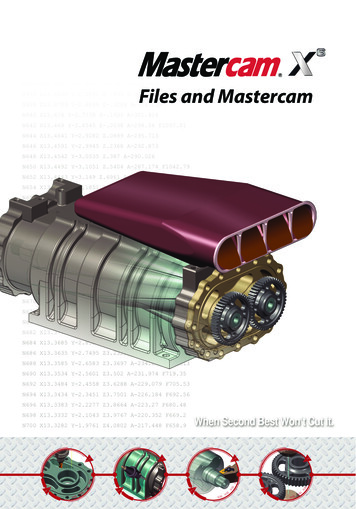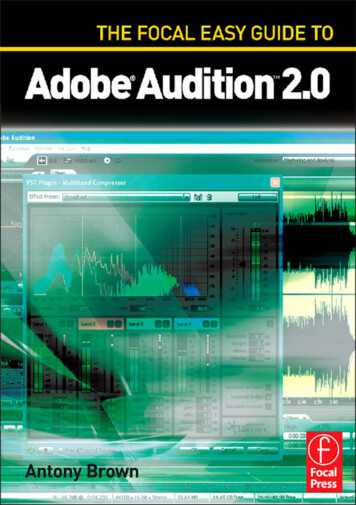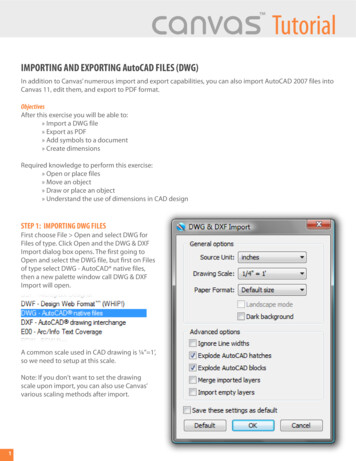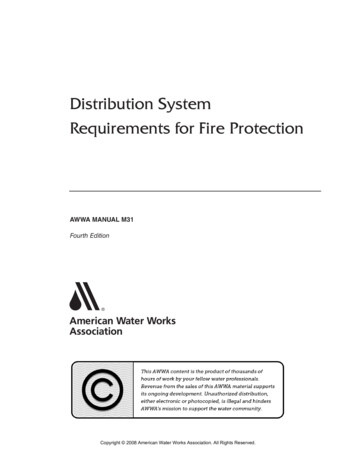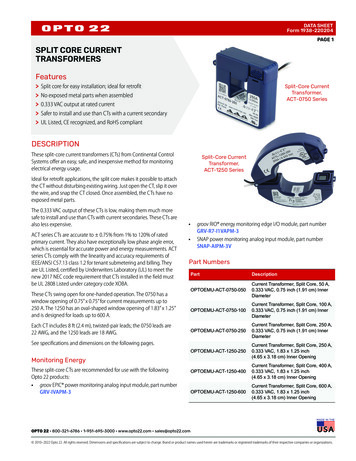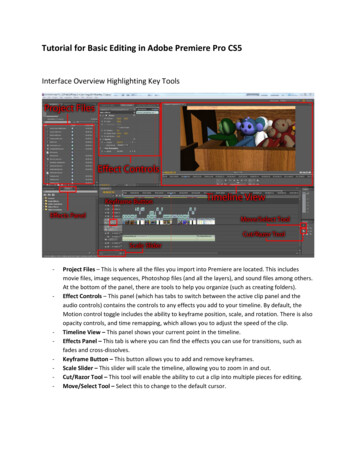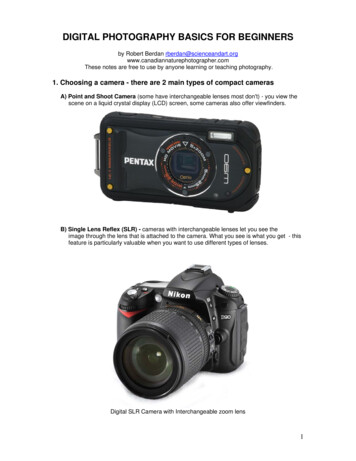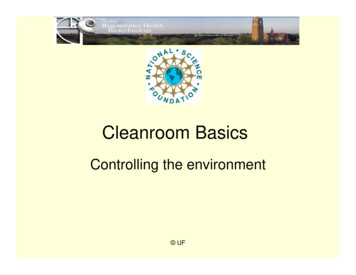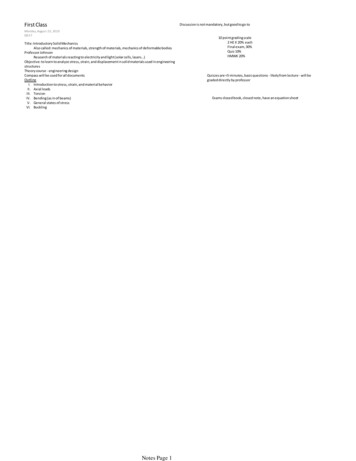
Transcription
First ClassDiscussion is not mandatory, but good to go toMonday, August 23, 201008:57Title: Introductory Solid MechanicsAlso called: mechanics of materials, strength of materials, mechanics of deformable bodiesProfessor JohnsonResearch of materials reacting to electricity and light (solar cells, lasers )Objective: to learn to analyze stress, strain, and displacement in solid materials used in engineeringstructuresTheory course - engineering designCompass will be used for all documentsOutlineI. Introduction to stress, strain, and material behaviorII. Axial loadsIII. TorsionIV. Bending (as in of beams)V. General states of stressVI. BucklingNotes Page 110 point grading scale2 HE X 20% eachFinal exam, 30%Quiz 10%HMWK 20%Quizzes are 5 minutes, basic questions - likely from lecture - will begraded directly by professorExams closed book, closed note, have an equation sheet
Statics Review (methods)Monday, August 23, 201009:17Example: Force analysis of a simple 2-member structureSo force A causes compression along ABThe two force components Cx and Cy together act along the line BCThus forces A and C make AB and BC two-force members - thus these forces must be collinearCould have more easily found the solution by taking a FBD of joint BThought experiment on axial deformation- We have a bar or two force member like BCWhat do we need to know to predict the change in length of the bar?Young's modulus of elasticity, EOriginal length, LCross sectional area, AForce being applied, FNotes Page 2
What do we need to know to predict the change in length of the bar?Young's modulus of elasticity, EOriginal length, LCross sectional area, AForce being applied, FNotes Page 3
Stress4/6 homework problems gradedSolutions posted to allPut a photo on compassHMWK: 1.13, 1.28, 1.32, 1.53, 2.19, 2.26Wednesday, August 25, 201009:01Why is AB thicker?So it is more rigid, and doesn't buckleIt is in compression, only compressed members can buckleQuantity that causes actual material failure is known as stress.Stress: an average distribution of forces over a cross -sectional area ve sign Tensile stress-ve sign Compressive stressEither can cause failureIn case of BC:We assume the distribution of forces is uniform in axial loadingUnits of stressForce per unit area: Nm-2, PaMore typical to use kPa or MPa or GPa in engineeringTo find the maximum stress before it breaks look for"ultimate stress""yield stress"Failure mechanisms are slightly different in tension or compressionOther considerationLoads/stress on joints or bearingsMember BC is said to be in an axial (uniaxial) state of stressThe actual spatial distribution of stress is statically indeterminantA different type of stress: shear stressShear stress: average shear on the planeContrary to axial stress: shear stress is not uniform (can't be uniform) on the cross section nor can it beassumed to beExample: commonly found in bolts or pins or rivetsNotes Page 4
Another kind of stress: bearing stresses: localized stresses at contacting surfaces between pins, bolts,rivets, and the surfaces they connectEX: the lateral area of the bolt rather than the cross sectionCan now completely analyze the stresses in the two-member structureNotes Page 5
Stress on an oblique (not perp.) planeHomework due WednesdayFriday, August 27, 201009:01Angle measured from verticalStress depends on coordinate systemIn 3 dimensions: general loading conditionsRecall:Notes Page 6
We have a set of stress componentsOnly six of the stress components areindependent of one anotherPlanes not lined up with coordinate system need sines and cosines, but there is no reason to do that.Back to 2 dimensionsWhy would we rotate it?Suppose we do not have a simple material - maybe wehave wood rather than steelOr maybe we have an angled joint glued togetherNotes Page 7
Uniaxial DeformationMonday, August 30, 201009:00What does strain have to do with material behaviour?DefinitionsStrainTwo quantities that together allow us to examine the materialStressStrainStrain and stress are linearly relatedNormal strain (axial strain)Also have shear strain laterNoteStrain is dimensionlessTypical numbers1m steel bar, stretched under tension by 0.01 mmStrain: 0.01E-3/1 10 -5, or 10 * 10 -6 (10 microstrain)Typical values are around 10 -4Comparing stress and strain gives us a way to measure the properties of the materialStress-Strain relationship- Can quantify in a lab (ME 330)- Experimental setupStandard tensile test sampleApply an increasing load (know A)Thus compute the stress and measure strainHave a load frameYield stress is yield strengthUltimate stress is ultimate strengthInitial part of curve is very steepAppears linear - have the behaviour we spoke ofMake a line thru 0.002 parallel to initial valueIntersects at yield stressNotes Page 8
Slope of the linear region is E from earlier (Young's modulus)3 important properties- Ultimate stress- Yield Stress- Young's modulusUltimate Stress Yield Stress Young's ModulusSteels250 MPa200 GPaAluminum 40 MPa400 MPa95 MPa70 GPaConcreteN/A25 GPa28 MPaConcrete ultimate stress is for a compression test rather than a tension testIn compression can get a bucklingBuckling effect at failure (also known as barreling)In tension can get neckingSample (before failing) thins out a lotNotes Page 9
Stress and Strain Axial LoadingWednesday, September 01, 201009:06Stress/strain machines must be very strong - more so than materialMaterials behave differently in compressive and tensile loadsStrength is affected by alloying, heat treating and manufacturingbut stiffness is not.If strain disappears when the stress is removed the materialis said to behave elastically.The largest stress for which this occurs is called the elasticlimit.When the strain does not return to zero after the stress isremoved, the material is said to behave plastically.Fatigue: shown on S-N diagramsNotes Page 10
Material may fail due to fatigue at stress levels significantly below theultimate strength if subjected to many loading cycles.When stress is reduced below the endurance limit, fatigue failures donot occur for any number of cycles.StressNumber of completely reversed cyclesModel material as a springNotes Page 11
More stress-strain relationships, uniaxial deformationFriday, September 03, 201009:13Increase in the yield stress: work hardening (strain hardening, strengthening)Fatigue of materialsFatigue: failure of a material at a stress that is lower than the yield stress due to repeated (cyclical)elastic loadingMust have very large amounts (10 6, 10 9 )Has caused plane crashesCharacterized by S-N curveAmplitude of the cyclical stressx-axis on a log scaleCurve represents the place where you expect it to fail after NloadingsSteel has a fatigue limit - there is a value of stress below which(regardless of times loaded) there is no decrease in its yield stressThis is statistical, not guaranteed (ME 330 has more of this)Number of loadingsDifference between engineering stress and true stress and engineering strain and true strainEngineering stressTrue StressEngineering strainTrue strainForcedivided by initial area The force over the current area Change in length divided by initial length The sum over the current areaHas no decrease during neckingNotes Page 12
Has no decrease during neckingDeformation under uniaxial loadingInternal force can vary in each segmentThen need free body diagramsNotes Page 13
Thermal strain, static indeterminacy, superpositionHomework 3 due next week - problems posted sometime todayWednesday, September 08, 201009:02Another way to increase the length of the barApply a temperature change, get a thermal strainIt is only zero ifthe bar isunconstrainedNo one is applying a force onit - expands freelyConcept of static indeterminacyUntil now, we could always get all of the internal forces by considering a free body diagramNotes Page 14
Many problems have more reaction forces than can be found from statics (a FBD) alone"statically indeterminant"Notes Page 15
Statically Indeterminant and SuperpositionFriday, September 10, 201008:59Statically Indeterminant: statics alone is not sufficient to find all of the reaction forces, so displacementsare also consideredSuperposition Method (Formally)Superposition method: "release" one boundary constraint and replace it with an unknown loadthat gives displacement that is compatible with the original problemSuperimpose the problems to get another oneWorks only with linear mechanics (same as in electriccircuits)Notes Page 16
Non-1-dimensional effectsToday: Poisson effectMonday: Multiaxial loading and generalized Hooke's LawFriday, September 10, 201009:28Lateral contraction characterized by Poisson's Ratio (greeknu)Ratio is a material property - can bemeasured or looked up.Generally positiveTypically ranges from 0 to 0.5.Impossible to be greater than 0.5according to theory. Could benegative though.Negative here - can be made in a lab certain minerals canNegative Poisson materialCurrently have two important material properties for elastic (isotropic) materials:Young's modulusPoisson's RatioAlso have coefficient of thermal expansion if are talking about thermo-elastic materialsMultiaxial loading: pulling or pushing in more than one directionUpon deformation, the new volume of the unit cube should beNotes Page 17
e: dilatationk: bulk modulusBetween pressure and dilitationConsider shear strainShear stresses will deform a cube into an oblique parallelepipedAngle changeAxial case does rectangular parallelepipedLength changeStill only two independent constants - can thus get G and kFor isotropic materialsIsotropic: material that is the same in all directionsRecapping strain as a function of stress2 constants are reduced from 36 by isotropyNotes Page 18
2 constants are reduced from 36 by isotropyWood, bone are not isotropicOffice hours MWF 2:30 to 3:50, 362 MEBHomework 3 has statically indeterminant problems, and Poisson effectNotes Page 19
Stresses near point loads and stress concentrationsHMWK 4 posted later todayOffice hours today are 2:00-2:50 (362B MEB)Wednesday, September 15, 201009:04Physical concept checkConsider a cube of materialRigid walls on each x-side, frictionless contact1. Consider ΔT 0i. What are axial stresses and strains2. Compressive load in z direction3. Tensile load in z directionStresses near point loadsOverall length change in both cases is the sameExact displacements near end are not the sameIn both cases the forces are statically equivalentDisplacements far from the end of the bar are the same in the ideal and actual caseSt. Venant's PrincipleStresses near defects or stress concentrations in materialFar from the loadWhich has higher stress along the centre line? - The one with the whole cut outActually it is much worse than thisExamine stress distribution near holeStress concentration: feature inside material that magnifies the stress relative tosome average or mean caseHow large is the peak stress?Notes Page 20
Stress concentration: feature inside material that magnifies the stress relative tosome average or mean caseHow large is the peak stress?'k' is a property of geometry, but not the materialExample: filleted plate/beamSmall r sharpBig r gradualStress distribution at filletImportant in brittle materials with possibility of defects (glass with bubble/microscopiccrack)Many structural engineering failures due to thisNotes Page 21
Plastic deformationG: shear moduluse: dilatationE: Young's ModulusFriday, September 17, 201009:15Portion of stress-strain behaviour of material that goes beyond the linear elastic region of the stress strain curveTau xy and tau yx are the same because momentsare zeroThis would be an elastic perfectly plastic materialResidual StressUpon unloading in an elastic-plastic material, often have stresses that are built in to the materialBy divine interventionNotes Page 22
Notes Page 23
Chapter 3: torsion of circular shaftsMonday, September 20, 201008:592 weeks from Wednesday is first midtermExam is during lecture hour in typical roomCompare and contrast with uniaxial deformation of barsTorsion state of deformation corresponding to pure shear, in which torque generates twist in a shaft.Applications: aircraft engines, automotive transmissions, bicycle design, wind turbines, hard drives, DVDplayersDouble arrow had right hand ruleCircular shafts: every cross-section of the cylinder remains circular andundistortedThis deformation generates shear forces on the cross sectionA line on the outside - like a candy cane after twistingTwist:The angle phi is twist (dimensionless) - comparable to delta in uniaxial case - the amountof deformation or displacementWhat is analogous to strain?Shear strainMaximum on the surfaceNotes Page 24
What is analogous to strain?Shear strainMaximum on the surfaceNotes Page 25
Think: why is a hollow shaft better per unit weight at resisting torque than a solid shaftNotes Page 26
HW 5 due on 29th, next WednesdayMidterm exam Wednesday 6 OctoberOn day of midterm may or may not be homework dueTorsion of Circular ShaftsWednesday, September 22, 201009:05zG: shear modulusJ: polar moment of inertiaRho: radial position coordinateGamma: strainTau: stressT: torqueRecall: stress distribution in circular shaft "internal force"Patch is equal to the top surfaceWhy is a hollow shaft better at resisting torque than a solid shaft (per unit weight)?Notes Page 27
Why? Putting material where stress is higher, so not wasting itSolving problemsStatically indeterminant onesIn uniaxial, would have a displacement equationTwo typesSay "fee", not "fie"Notes Page 28
Problems on TorsionI. Statically determinantII. Statically indeterminantFriday, September 24, 201009:11Midterm (on Wednesday, 6 October) will be more like homework problems than quiz problems(problem solving rather than concepts)Probably 2-6 problems on examHomework 5 has been posted due Wednesday 29 September90/12 7.5Left side is solid, right side is hollowOuter diameter is 7/8 inchInner diameter is 5/8 inchG 10*106 psiT 90 ft.lbNotes Page 29
Notes Page 30
Exam 1 next WednesdayWill have an equation sheet, but closed notes/booksNo HMWK due that dayNo practice examMay or may not have calculatorPlastic deformation in torsionMonday, September 27, 201009:00If we keep increasing T:We eventually hit the yield in the material - material goes plasticOuter part is behaving plasticallyAs we increase T, eventually the entire cross section "goesplastic"SinceNotes Page 31
Metals are ductile, concrete is brittle, has no plastic partExampleNotes Page 32
BarNotes Page 33
No homework due to exam next weekExam 1 is next Wednesday (6 October)Will cover material through this weekWill post a practice test, but no solutionsWill post suggested problems for this week as we don't have a homeworkTorsionWednesday, September 29, 201009:00Three things left1. Residual stress2. Torsion in non-circular shafts3. Thin-walled hollow shafts in torsionRecall: elastic-perfectly plastic shaft in torsion (good approximation for metals)Elastic everywherePart elastic, partplasticPlastic everywhereNotes:Notes Page 34
Notes:- Stress not uniform- Stress is only zero at one radial position (a ring on the cross section)- Tau is still equal to tau y at the centerResidual stress distribution in a hollow cylinderThere does not have tobe a zero stress pointNext topic: torsion in non-circular shaftsWhen a twist is applied, cross sections do not remain planar or undistortedWe can show that the shear stress is not uniform around the edge of the square- Not the same about a circle eitherThere is no shear stress at the cornersMaximum shear stress occurs at midlines of the sidesCan also look up values for rectangular cross sectional shaftsStill has rotational symmetryNotes Page 35
Still has rotational symmetryShorter side will be squared/cubedTorsion of thin-walled hollow shaftsConsiderNotes Page 36
Torsion of thin walled hollow shaftsFriday, October 01, 201009:07Exam on WednesdayIn this room (103 Talbot)He will not be hereWill be two TA's (Tapan and melee)Cut off at 9:502 or 3 problemsHave equation sheet - will have more or less any equation we have seen (want an equation, email him it)He will not be here Monday - Tapan will do problems during lecture thenOld exam from last fall onlinePosted 10 problems from chapters 2-3 and solutions which he believes are usefulNo homework that dayAnalogy with fluid flowThe largest shear stress occurs where the wall thickness is smallest and vice versa.Also, can get a relationship between shear stress and thicknessA: area inside the midline of the shaftNotes Page 37
Notes Page 38
Bending (chapter 4, 5 is analysis and design of bending)Friday, October 08, 201009:00He will grade them himselfBack probably by WednesdayNo homework due this Wednesday (13th)Next homework will be due Wednesday, 20 OctoberSimple examples:Case 1Case23 reaction forcesCase 3More complicated - includes bending and torsion and axialConsider case 1Case 13 reaction forcesConsider case 2Interesting: M is constant in the centreIn any case where we have bending, the members have resultant bending moments acting in the cross section of the member (NOTE: member refers to beam)Consider the sign of the resultant momentIf the beam bends likeThen we consider M to be PositiveIf the beam bends likeThen we consider M to be NegativeConsider stresses on the cross sectionConsider a prismatic beam cross section in bending with moment MNotes Page 39Sign convention
On A:No moment in zdirectionyAll grid elements have same shape, cross sections remain planeCxConsider elements near the topThey are in compressionConsider elements near the bottomThey are in tensionConsider elements in the middleSomewhere in between it will be zero, ascontinuous from positive to negativeLength of that particular line is not changingThis somewhere is called the neutral axis (If niceand symmetric then at the midplane)Notes Page 40
Beam bending - stress distributionExams back on WednesdaySo far looking badHMWK 6 due Wednesday, 20 OctoberMonday, October 11, 201009:01Recall: section of a prismatic beam in pure bending (section has only bending moment, not axial load ortorsional load)Only non-zero stress is purely axialConsider neutral axis - figure out the stress distributionL: length of neutral axisStrain varies linearly as a function of distance from theneutral axis (and the stress does too)What is largest value of strain?Where is the neutral axis?ConsiderThe first moment of the cross section with respect to the neutral axis iszero. That is to say that the neutral axis passes through the centroid.Consider another integralNotes Page 41
Consider another integralTherefore the moment of inertia times the maximum stress over the radius ofcurvature is the momentMoment of inertia, IHeight is better than width at resisting bendingExampleNotes Page 42
Special topics in beam bendingWednesday, October 13, 201009:21Key results from last time:- Neutral axis of a bending beam passes through the centroid (Neutral axis: undergoes nostrain) Beam is in pure bending Neutral surface probably would be a better term- Formulae:Average 29.6, regrade due WednesdayGet average scoren 94, range 15 - 50 (3 perfect)HMWK 6 due Wednesday too - make separateAnticlastic curvature- Curvature out of plane due to pure bendingLike eraserStress Distributions in beams made of either1. Two different elastic materials2. An elastic perfectly plastic materialIt is a jump (unless microscopic)Notes Page 43
Shear force and bending moment diagrams (5)HMWK due Wednesday, as areexam corrections - submitseparately from each otherTurn in exam with graded oneFriday, October 15, 201009:11Goal is to determine the internal forces and moments in a bending beamVxMxNotes Page 44
Notes Page 45
Bending moment and shear force diagrams (cont.)Next time bring HMWK 6
Example: Force analysis of a simple 2-member structure So force A causes compression along AB The two force components C x and C y together act along the line BC Thus forces A and C make AB and BC two-force members -thus these forces must be collinear Could have more easily found the solution by taking a FBD of joint B
